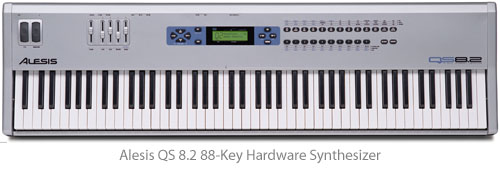Hardware Synths
Welcome to the wonderful world of hardware synths.
Let's make an important note right off the bat.
Keyboard Synthesizers and Digital Pianos have some key differences, but overall are very similar.
In the big picture - both types of hardware synths are simple to add to your home studio rig, and often times both can be used as MIDI Controllers for a Software Based Synthesizer.
Whereas guitars have been around for hundreds of years, the digital synthesizer is a relative newcomer.
Only commercially available for about 50 years it has become massively popular in the last 25 years and is heavily used in all genres of music today.
But that's enough history lessons for today! Let's learn some of the nuances between the Digital Piano and the Keyboard Synthesizer.
Digital Pianos
Digital pianos are simply hardware synths that specifically emulates the sound and feel of a traditional piano.
This is achieved through piano sampling, the number of keys, and the action of the keys.
Digital pianos are sampled from some of the most famous and rare stage pianos available.
These samples are taken at various dynamic ranges and recorded from multiple locations within the piano itself.
As a result, the data files tend to become very large as the amount of data required to provide such a detailed model increases.
From a playability perspective, you'll notice that they come in a variety of sizes.

The common lengths are the full 88 keys, 76 keys, and 61 keys.
The reduction in size takes keys from the highest and lowest registers, which are not used very often anyway. But in the end this comes down to personal preference.
Finally, the action refers to the feel of the keys themselves. Terms such as weighted, hammer action, and graded hammer action will make up almost any digital piano description.
Weighted keys simply have counter weights in them to give the keys some resistance when you press on them.
They feel slightly heavier than the keys on an organ.
Hammer action means that pressing the key will physically move a hammer, just like in an actual piano.
The difference is that since this is a hardware synthesizer of a piano, there are no strings to strike. But the feel is remarkable true to a traditional piano.
Graded hammer action is one step closer to the real deal. It varies the pressure required to press each hammer action key down as you go to the higher registers.
In other words, the higher the notes the easier it is to press. This is a very subtle feature but does have an added element of realism.
Keyboard Synthesizers
Keyboard synthesizers are the other main example of hardware synths that I'll discuss.
Unlike the digital piano, which focuses on piano samples, the keyboard synth often has hundreds of samples ranging from church organs to entire string sections to drums to raw square waves.
The keyboard synth typically has weighted or semi-weighted keys that have a very light touch, and comes in a wider variety of sizes.
Whereas the digital piano stuck to 88, 76 or 61 keys, these boards can really go anywhere down to 25 key mini controllers.
The sheer number of samples included in a modern keyboard synth is truly staggering.
You will find, however, that the quality among these samples varies greatly.
Some keyboards have an application to tweak different parameters of the samples to save in a custom bank.
Another nice feature is an on-board sequencer to record with. This is limited to the higher end machines and requires you to do all your editing on the tiny screen on your board.
But for practicing a simple riff or getting an idea down quick, it can be a useful tool.

Arpeggiators allow you to brainstorm some ideas by having the synth play an arpeggio sequence depending on some inputs you provide.
It can be a great way to get over a hump or just get a fresh idea going. This feature can also be found in most Recording Software.
Polyphony refers to the number of notes that can be played back simultaneously (32 or 64 note polyphony are common benchmarks).
You may ask, "How am I ever gonna play 64 notes at the same time?" A piano sound layered with violin samples and some reverb added for effect can start to add up in a hurry.
But the reality is that unless you are pushing the envelope with layers and effects, even 32 will be more than enough.









